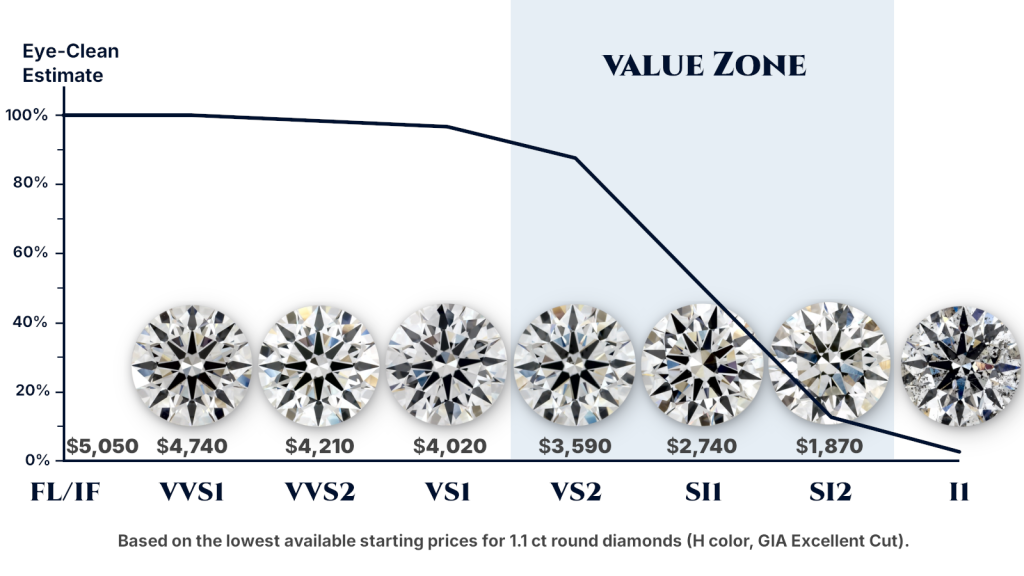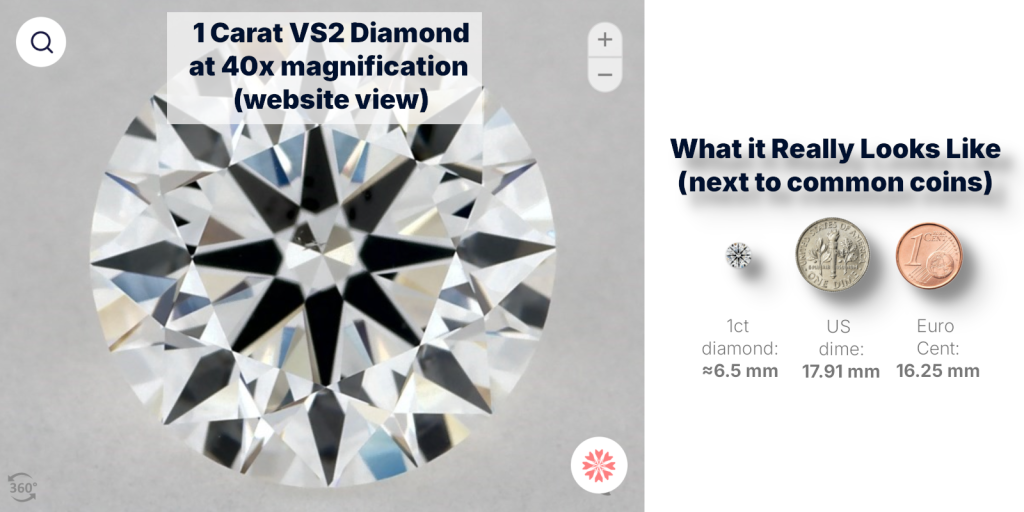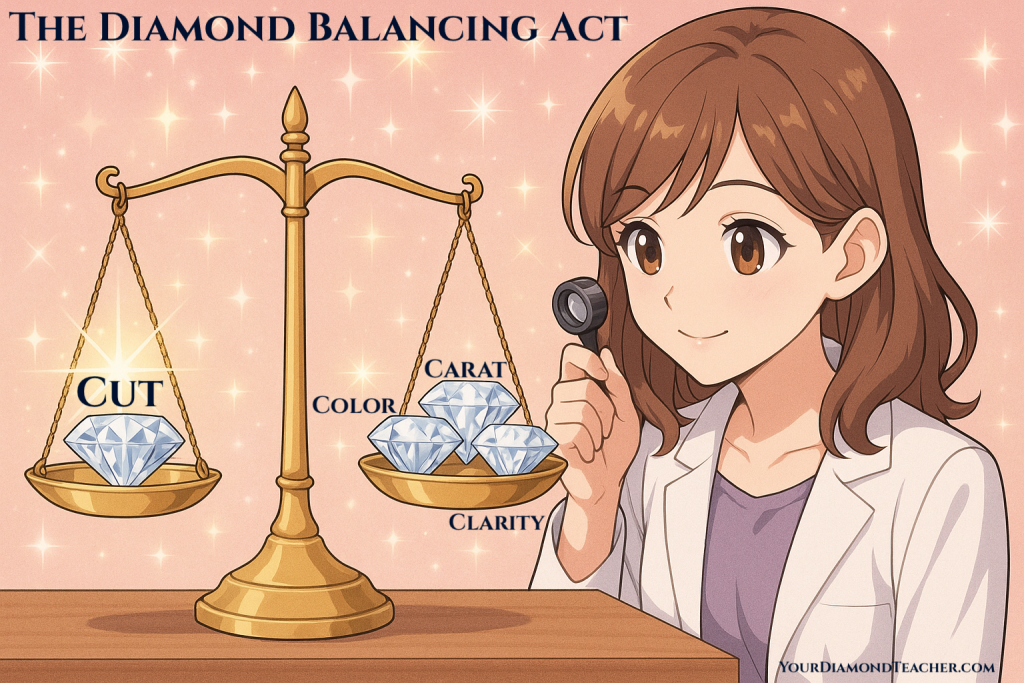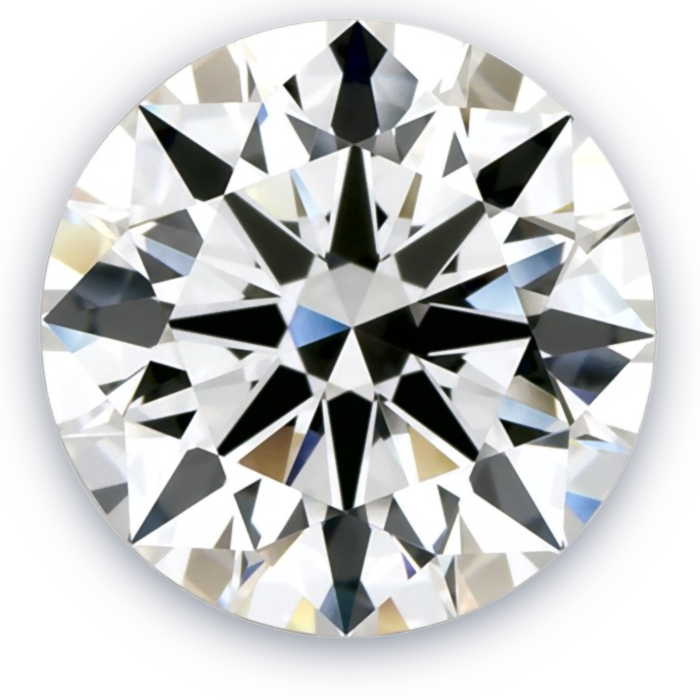Diamond clarity is all about how clean your diamond looks, both under magnification and to the naked eye. Clarity refers to the presence or absence of natural imperfections, called inclusions (inside the diamond) and blemishes (on the surface). The fewer and smaller these flaws, the higher the clarity grade. But don’t be fooled by grading jargon: most of these imperfections are microscopic and have little to no impact on beauty in real life.
What really matters is whether a diamond looks eye clean, meaning that you cannot see any inclusions with the naked eye when viewed under normal conditions. This standard is far more practical than what shows up on a lab report and it is where real value can be found. In this guide I will walk you through each clarity grade, explain how eye-cleanliness plays into it and show you exactly where it makes sense to spend or save.
Compare All Clarity Grades Side by Side
When it comes to diamond clarity it helps to see how each grade compares without digging through endless technical charts. The slider below gives you a quick way to gather all the most important facts. All prices in the slider are based on 1.1 carat diamonds, the average size for natural stones as of October 2025. I chose H color as a balanced and popular option and all examples are GIA graded naturals for reliable comparisons. I also used starting prices instead of averages because they show more clearly how costs shift across clarity grades.
Looking through the slider you can see how clarity impacts both appearance and price in real terms. The differences from one grade to the next are often tiny, yet the price jumps can be dramatic and rarely make sense for most buyers.
Diamond Clarity Grades Explained
Clarity grading is the process labs use to describe how clean a diamond looks under 10x magnification. At the very top are Flawless and Internally Flawless diamonds which have no inclusions or only the faintest surface blemishes. These are technically impressive but the difference is invisible in everyday life.
Below that are the VVS grades which stand for Very Very Slightly Included. These diamonds have tiny imperfections that are extremely hard to detect even for a trained grader. VS or Very Slightly Included grades are where inclusions become easier to find with magnification but are still invisible to the naked eye in most stones.
SI or Slightly Included diamonds are where inclusions can sometimes be seen without magnification. Many SI1 diamonds still look completely clean in real life while SI2 is a mix of good value finds and stones with obvious flaws. I clarity diamonds fall at the bottom of the scale and most show inclusions that anyone can spot.
The idea of eye-cleanliness is more important than the grade itself. A diamond is called eye clean if you cannot see inclusions with the naked eye when viewed normally. This is what really matters for beauty because once a diamond looks clean to you, going up in clarity does not improve its appearance. For example, a carefully selected VS2, SI1 or even SI2 diamond can look just as eye clean as a VVS or IF stone while costing much less.

When you look at the Value Zone highlighted in the chart above (VS2 to SI2), you can clearly see where the real trade-offs begin. At VS2, the eye-clean estimate drops to around 85-90%. That means while most VS2 diamonds still appear perfectly clean to the naked eye, there are exceptions like this surprisingly flawed VS2 diamond where an inclusion is very clearly visible. This is why selection matters even with VS2 diamonds.
As you move further into SI1, the chances of finding an eye-clean diamond fall to roughly 50%. Half of SI1 stones will look clean, the other half will show inclusions without magnification. SI2 takes the risk further: only about 10-15% of diamonds at this grade are truly eye-clean. These can be incredible value finds if you choose carefully, but they require much more scrutiny compared to VS2 or SI1.
PRO TIP:
Once you move past VS2 selection matters more than anything. Cast a wide net so you can compare many stones side by side. James Allen has the largest online diamond inventory which makes it easy to filter by images and grading details.
If you prefer a simpler path with a clear eye-clean callout, Whiteflash labels eye-clean on each listing and focuses on elite cuts. This removes guesswork if you want certainty.
When you move into I clarity grades the trade-offs become steep. Most reputable vendors only carry diamonds down to I1 because I2 and I3 stones always have obvious inclusions that distract from the beauty of the diamond. Even at I1 only about 0-5% of diamonds are eye-clean. And while finding one of those rare clean I1 stones may sound like a win, like this rare eye-clean I1 diamond that truly defies expectations, the reality is that they rarely offer better value than an eye-clean SI2.
In my slider you may have noticed that starting prices for I1 diamonds were actually slightly higher than for SI2, which feels absurd at first glance. While these shifts can vary month to month depending on availability, it underlines the point that I1 diamonds are not worth pursuing, even from a pricing perspective. While prices at I1 often overlap with SI2, so even when you get lucky the savings are negligible or non-existent. I2 and I3 diamonds are worse still, with virtually no chance of being eye-clean and inclusions that overwhelm the sparkle.
Not all inclusions are equal either. A small crystal off to the side may never be noticed while a dark mark under the table can be distracting. Two diamonds with the same grade can look very different which is why images and videos are critical for judging eye cleanliness and not just the lab grade.
Which Clarity Grade Offers the Best Value?
The image in the section above already makes the answer clear: VS2 through SI2 diamonds provide the greatest value. This is the stretch of the clarity scale where price and beauty balance out best. What I want to do here is go one step further and help you decide which of these grades is the right fit for you.
VS2 is the safest entry point into the value zone. At this grade the vast majority of stones still appear completely clean to the eye. There are cases where an inclusion is visible but most VS2 diamonds will give you the look of a higher grade without the unnecessary premium. If you want peace of mind without overpaying this is a solid option.
Many shoppers still lean toward VS2 or higher because of the reassurance factor. I know that many people worry that someone with sharper eyesight might catch a flaw in an SI1 or SI2 diamond. That concern is understandable, but in practice it is almost always a myth. Even people with weaker eyesight usually wear glasses or contact lenses, so what you can’t see almost nobody else will. Unless someone takes your ring off and inspects it under very specific lighting, they will not notice the difference.
Going higher than VS2 can also be about the confidence of seeing a higher grade on the report. For some, it even ties into the same bragging rights I mentioned earlier in the slider with grades like IF or VVS1. If that feels good to you and you do not mind paying extra, then there is nothing wrong with it. Just know that technically it is never necessary to go above VS2 if your goal is a diamond that looks perfect in real life while paying the lowest possible price.
When shopping online, keep in mind that vendor images usually show your diamond at 40x magnification. At that level, even the tiniest crystal or feather looks dramatic. The goal is still to find a diamond with as few and as light inclusions as possible, but you should balance that with how the stone actually appears in real life. A feather inclusion sitting right in the center, for example, can look scary under magnification yet remain completely invisible once the diamond is set, especially if it isn’t dark. The VS2 diamond in the image below is a good reminder of this effect: under 40x zoom the feather inclusion in the center looks exaggerated, but in real life you’re looking at something only a few millimeters wide. This is a perfectly eye clean diamond:

SI1 is where the real savings begin. About half of all SI1 diamonds are eye clean which means careful selection is required. The key here is to review actual images and grading reports so you know what you are getting.
One detail to watch closely is the type and position of inclusions. Avoid dark crystal inclusions under the table since these can appear as tiny black specks that catch your eye in real life. At this grade you will often see feathers, clouds, or small crystals. Many of these are harmless if they are faint or tucked toward the edges. SI1 diamonds are best for buyers who are willing to put in the effort. It takes comparing multiple stones side by side to spot the winners, but if you are patient the payoff is absolutely worth it.
SI2 takes the risk further but it can also deliver the biggest rewards. Only about one in ten SI2 diamonds are truly eye clean which means you have to sift through many to find the rare winner. When you do land one it can be one of the best value purchases on the entire clarity scale. This is where shoppers with patience and sharp eyes are rewarded.
If you are the kind of person who enjoys the hunt and does not mind spending hours filtering through listings, then SI2 is your playground. At this grade, it is not just about inclusion type but also inclusion severity. Large dark crystals and clusters of clouds are dealbreakers, while faint wisps or transparent feathers may still pass as eye clean in the right stone. SI2 is a gamble, but the payoff for careful buyers is unmatched.
The important point is that once a diamond looks eye clean to you higher clarity grades add no visible benefit. The smart move is to identify the grade where you are comfortable with the risk of visible inclusions and redirect the savings into carat weight cut or color. That is how you maximize both beauty and value without paying for features that no one will ever see.
One important nuance is that shape and size influence how visible inclusions are. Round brilliants are the most forgiving, so you can safely dip lower in clarity without seeing a difference. Step cuts like emeralds and Asschers have big open windows that make inclusions easier to spot, so VS2 or higher is generally the safer target. Larger diamonds (around 1 carat and above) also tend to reveal inclusions more than smaller ones, which is why experts often recommend VS1 or VS2 for those stones:
| Diamond Shape | Clarity Guidance | Key Points |
|---|---|---|
| Round Brilliant | VS2-SI1 (sometimes SI2) | Rounds hide inclusions best thanks to their facet pattern. Many sub-1 ct stones are eye-clean even at SI1. SI2 is possible but requires careful inspection. Eye-clean SI2 (yes, really) vs. SI2 you’d never pick. |
| Princess Cut | VS2-SI1 | Like rounds, princess cuts mask inclusions well. SI1 is often safe, SI2 is risky but possible with very careful review. |
| Emerald & Asscher (Step Cuts) | VS1-VS2 | Large open tables make inclusions obvious. Stick to VS2 or higher, SI1 works only with very careful selection. |
| Cushion, Oval, Radiant, Marquise, Pear | VS2-SI1 | These brilliant styles hide inclusions decently. SI1 is often fine, SI2 can work in some stones, but needs extra scrutiny. |
That said, these are guidelines rather than hard rules. With careful selection, you can still find a VS2 step cut, even in the 3 carat range, that looks completely clean to the eye. The key is not just relying on the grade but reviewing actual images and vendor inspections to confirm eye-cleanliness.
Which Diamond Inclusions Should You Avoid?
Not all inclusions are created equal. Some have almost no impact on appearance, while others can hurt brilliance or stand out to the naked eye. The key is knowing which types are harmless and which ones you should avoid.
Dark Crystals and Carbon Spots
Crystals are common inclusions, but their impact depends on their size and location. Small, white crystals off to the side are usually harmless. Dark crystals, sometimes called carbon spots, are the opposite. If they sit under the table or near the center, they can be visible without magnification and draw the eye right away.
Feathers
Feathers are internal fractures that can look like tiny cracks. Most feathers are fine if they are small and on the side of the diamond, especially if they are white or transparent. The ones to watch out for are dark feathers or large ones that run toward the surface. These can be seen in certain lighting and in extreme cases may even affect durability.
Clouds
A cloud is a group of tiny pinpoints clustered together. On their own, clouds are usually harmless. Many SI1 or SI2 diamonds with small clouds are still perfectly eye clean. The problem is when clouds are large and dense. These can make a diamond look hazy or milky, reducing its sparkle even if the grade looks fine on paper.
Needles and Pinpoints
Needles are long, thin inclusions that often look like tiny white or clear lines. Pinpoints are even smaller dots. Most of the time they are not an issue, especially if they are scattered. The only concern is when they cluster together under the table, where they can form a hazy area similar to a cloud.
Chips and Cavities
These are surface-reaching inclusions and should be avoided whenever possible. Chips and cavities can weaken the diamond and catch dirt, which makes them more noticeable over time. Even if a vendor discounts such a diamond, it is not worth the risk.
GIA vs IGI: Which Diamond Certificate Can You Trust?
So far in this article, all the examples we have looked at have been GIA-graded diamonds. That makes sense because GIA has long been considered the most prestigious grading authority for natural diamonds. At the same time, IGI has carved out a dominant role in grading lab-grown diamonds and is by far the most common certificate you will see in that category. While this article is focused on natural stones, it is worth noting that IGI has also been gaining steady ground in natural diamonds. For instance, as of October 2025 you can find roughly 10,000 IGI-graded natural round diamonds on James Allen compared to about 89,000 GIA-graded natural round diamonds, showing that GIA still leads in earth-mined diamonds but IGI is increasingly present.
One reason GIA still dominates is cost and prestige. A GIA grading report for a 1 ct diamond currently costs 113 USD, while the same diamond graded by IGI costs only $20. For larger diamonds the difference grows: a 5 ct GIA report is $535, while IGI still charges only $20. This means that even before a diamond reaches you, GIA adds noticeably more overhead for the retailer to absorb. Unsurprisingly, those costs get baked into the final retail price.
Historically, IGI has carried the reputation of being more lenient in grading compared to GIA. That meant a diamond labeled SI1 by IGI might in reality be closer to an SI2 by GIA standards. The same went for color and cut. In recent years though, IGI has made noticeable improvements in consistency and is stricter than it used to be. From my own experience reviewing many GIA and IGI diamonds side by side, I would say that in practice there’s hardly any difference in clarity grading between the two labs. The only place where I still notice a slight gap is in color: IGI can sometimes be just a touch more lenient there.
For buyers, this raises a practical question: should you only buy GIA diamonds? The short answer is no. If you are set on the prestige and reassurance of having the most recognized certificate in the world, then GIA is the obvious choice. However, if you are flexible and more focused on overall value, IGI-graded natural diamonds can offer some decent savings. That is especially true if you are confident in reviewing images and videos yourself instead of leaning only on the paper grade, which after reading this article, you should be.
One way to think about it is that GIA gives you confidence on paper, while IGI allows you to potentially save money if you do the legwork yourself. For example, if you are considering two diamonds that look identical in images and video, one GIA and one IGI, the IGI stone may well be around 10% cheaper simply because of the grading authority. For many shoppers, that saving is better spent on carat weight, cut quality or even the setting.
In the end, both GIA and IGI provide a reliable starting point for assessing a diamond. But if you do not need the prestige of a GIA report, an IGI-graded natural diamond can absolutely be a smart buy as long as you take the time to verify eye-cleanliness and overall cut quality with your own eyes. Think of GIA as the “gold standard” and IGI as the “value option” that has steadily been improving. Both can work, but the right choice depends on whether you want the extra confidence of the strictest grading or the extra flexibility of a lower price tag.
Clarity vs. Size, Color and Cut
Clarity is only one piece of the diamond puzzle, and it’s often given more weight than it deserves. To put it in perspective: clarity is about how free a diamond is from inclusions, but those inclusions are often invisible without magnification. And if you pick the right diamond, they should be invisible. Size, color and cut, on the other hand, affect how your diamond looks every single time you glance at it. That’s why it’s important to see clarity as part of the bigger picture, not the whole picture.

When it comes to size, even a tiny jump in carat weight can make a diamond look significantly larger on the finger. If your budget is tight, it often makes more sense to accept a slightly lower clarity grade (say SI1 instead of VS2) if that allows you to afford a bigger carat size. You’ll notice the presence of size every day, while you’ll almost never notice a well-placed inclusion.
Color is another area where clarity takes a back seat. A diamond that looks too warm or yellow in certain settings can be distracting, even if it’s graded flawless for clarity. If you have to choose, put your money toward achieving the right color balance for your setting and your taste. A clean-looking SI diamond paired with the right color grade will almost always look better than a higher-clarity stone that faces up very slightly tinted.
Above all else, cut quality is the most powerful driver of beauty. Cut determines fire, brilliance and scintillation: the very things that make diamonds so captivating. Even a flawless diamond can look dull if it’s poorly cut, while a modestly graded clarity diamond with an excellent cut will light up a room. Never sacrifice cut for clarity, it’s the one factor that brings everything else to life.
The takeaway is simple: once you reach a clarity level that’s eye-clean, stop climbing the scale. You don’t need to pay for perfection that you’ll never see. Instead, redirect your budget toward a bigger size, a better color balance, or an ideal cut. This is where large online inventories like James Allen and Blue Nile really shine, because you can filter by clarity and then compare dozens of options until you find the right balance of size, color and cut. If you prefer not to spend time analyzing images, Whiteflash makes things easier by labeling every diamond for eye-cleanliness.
So think of clarity as the supporting role, not the star of the show. The right strategy is to lock in an eye-clean diamond and then let size, color and especially cut do the heavy lifting. That way you get a diamond that looks stunning in real life, not just on paper.
Diamond Clarity FAQs
More Clarity Topics to Explore:
- Are IF clarity diamonds worth the premium?
- Should you pay extra for a VVS1 diamond?
- Best reasons to buy a VVS2 diamond
- Is VS1 clarity eye clean in real life?
- Is VS2 clarity good enough for an engagement ring?
- Why SI1 diamonds are the value hunter’s favorite
- SI2 clarity: risk and reward explained
- Best value: SI1 vs SI2 diamonds compared
- What are the most common diamond inclusions?
- Feather inclusions: when to avoid them
- How different clarity grades look in real life
